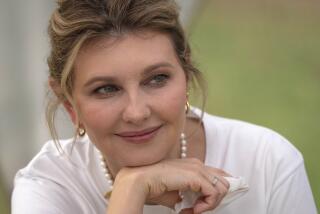Arms Talks Remind Girl of Her Soviet ‘Summit’
- Share via
Katia Koerner of Yorba Linda will be watching this weekend’s summit meeting between President Reagan and Soviet leader Mikhail S. Gorbachev very closely. She is probably one of few 15-year-olds in the world who understands exactly what it’s like to meet the Soviets face to face to talk peace.
Katia spent part of her summer vacation attending a peace conference for teen-agers held in the Soviet Union. The conference was sponsored by the National Council of American-Soviet Friendship Inc. Nine 14- and 15-year-olds were selected to represent the United States at the conference, which also hosted 140 other nations. More than 2,500 teen-agers, equally divided between boys and girls, attended.
What the Esperanza High School freshman discovered during the conference was that teen-agers are teen-agers, regardless of their different cultures, languages and governments. She is hoping that Gorbachev and Reagan will put aside their differences and get to know each other personally.
“I think the more that they talk to each other, the less they’ll be afraid of each other,” Katia said. “By talking to each other face-to-face, they’ll get to know one another. It can’t hurt to talk about peace. It can’t hurt to talk about reducing nuclear arms. A lot of good can come out of this.”
Culmination of a Dream
Katia’s trip to Moscow and then to Yalta this summer was a culmination of a dream to learn more about her Russian ancestry. Her great-grandparents were born in Russia and her mother, Victoria Koerner, always had a keen interest in Russian literature and film.
To be selected, Katia had to write essays on why she wanted to attend the conference, obtain recommendations from teachers and family friends, and have parental permission. Once selected, she was sent to a one-week orientation class held near New York City.
“We were taught some of the language and history and how to react in certain situations,” Katia said. “The main thing they told us was not to look down on the Soviets or somehow make them think we were superior--you know, like saying our government was better than their government.”
The first thing that impressed her about Moscow was its cleanliness, she said.
“Everything was so neat--there weren’t any markings or graffiti on the walls,” Katia said. “Everything was clean. And I saw a lot of posters with peace messages. I guess I didn’t expect that.”
She was also impressed by the friendliness of the Soviet people. They were curious about the delegates from different countries, especially about the Americans, and went out of their way to be friendly and helpful, she said.
Katia stayed with other delegates in dormitory-style rooms at Camp Artek, a Young Pioneers camp on the Black Sea. Her roommates included representatives from Ghana, India, Yugoslavia and the Soviet Union.
Conferences Held Every Day
Conferences were held each day to discuss world problems. The No. 1 problem, Katia said, was the nuclear arms race.
“Everybody decided that peace could be achieved if we could stop the nuclear arms race,” she said. “It was on everyone’s mind. We don’t want to see the world blown up. So we exchanged ideas on how to prevent a nuclear war.”
Some of the ideas included writing letters to world leaders and organizing peace walks, Katia said.
Alan Thomson, executive director for the New York-based National Council of American-Soviet Friendship Inc., said the peace camp has been held every year since 1967.
“The program became very popular after Samantha Smith made her trip to the Soviet Union in 1983--she became the patron saint of peace for children,” Thomson said. “Her death (in 1985 in a plane crash) was a real tragedy. Our program is aimed to carry on the concept of peace through our children.
“We look for promising young people who will benefit from the experience,” Thomson said. “We want to eliminate misunderstandings that people in different countries have about each other.
“A lot of the teen-agers who have participated in this program have gone on to study international relations in college,” he added.
Katia’s trip to Moscow was nearly canceled due to the Chernobyl nuclear plant accident. Victoria Koerner recalled that she was afraid her daughter would be exposed to dangerous radiation.
“I wasn’t afraid of terrorists or anything like that as much as I was frightened of possible radiation in the food,” Koerner said. “I called everyone I could think of to find out if it was safe. I talked to the State Department, the head of the nuclear physics deartment at Stanford (University) and experts in foreign policy at UCLA.”
The director for international programs at Chapman College, Koerner said she supports the idea of children and teen-agers meeting their counterparts throughout the world to learn about each other. For many years the Koerners have regularly had exchange students stay in their home, the family’s small contribution to world peace, Koerner said.
“These children are our future,” she said. “Attending camps like these should further understanding in her generation. When Katia came home, she told me she was so surprised that most of the kids were really the same. I believe that’s important for them to know.”
Music, clothes and boys dominated much of the private conversations, Katia said. The most popular musicians were Wham!, Bruce Springsteen and Duran Duran. Pins were exchanged as small tokens of appreciation and everyone walked away from the conference with new friends, she said.
As part of her obligation to the friendship organization, Katia will be required to share her experiences by giving talks to various groups, including junior and senior high school students. She plans to be very busy this year. In addition to being on her school’s varsity swim team, she plays clarinet and works as a candy striper at St. Jude’s Hospital in Fullerton.
“I’ve already gotten letters from people at the camp,” Katia said. “I’ve been so busy that I haven’t had time to answer them.”
More to Read
Sign up for Essential California
The most important California stories and recommendations in your inbox every morning.
You may occasionally receive promotional content from the Los Angeles Times.













